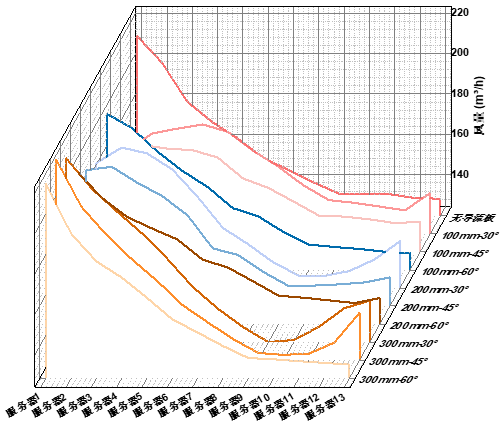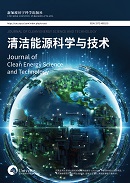导流板对数据中心气流组织优化及节能的模拟与实验研究
DOI:
https://doi.org/10.18686/cncest.v2i1.97关键词:
数据中心;气流组织;ANSYS模拟;导流板;能效提升摘要
数据中心气流组织直接影响数据机房的室温控制及供冷设备的能效。鉴于数据机房底层服务器由于距离开孔地板过近、气流的水平速度分量小,导致下层服务器风量不足、冷却效果较差问题,本文通过安装导流板的方式提升机柜级别垂直方向的气流均匀性,从而改善机房内整体气流组织效果。基于多工况实验和数值模拟相结合的方法优化数据中心的导流板结构尺寸及布置形式。研究结果表明,对于单侧机柜送风,建议在开孔地板下方安装宽度为100 mm、角度为45°的导流板;对于两侧机柜送风,导流板宽度为100 mm且与开孔地板呈30°角度安装可以获得最佳的气流组织效果,机柜底层服务器的进风量明显增加,降低了发生局部热点的风险。最后,基于最优的导流板布置形式对某真实数据中心机房的气流组织开展ANSYS模拟仿真,对比实际未安装导流板的情况,导流板的优化布置使机柜的进风量增加16.98%,提升机房空调能效达1.98%。

##submission.downloads##
已出版
文章引用
期
栏目
执照
版权声明
##submission.license.cc.by4.footer##参考
1. 中国制冷学会数据中心冷却工作组. 中国数据中心冷却技术年度发展研究报告, 2019. 中国建筑工业出版社; 2020.
2. China Refrigeration Society Data Center Cooling Working Group. China Data Center Cooling Technology Annual Development Research Report 2019 (Chinese). China Architecture & Building Press; 2020.
3. Ajayi O, Heymann R. Data centre day-ahead energy demand prediction and energy dispatch with solar PV integration. Energy Reports. 2021; 7: 3760–3774. doi: 10.1016/j.egyr.2021.06.062
4. Du Y, Zhou Z, Yang X, et al. Dynamic thermal environment management technologies for data center: A review. Renew Sustain Energy Rev. 2023; 187: 113761. doi: 10.1016/j.rser.2023.113761
5. Ristic B, Madani K, Makuch Z. The water footprint of data centers. Sustain. 2015; 7: 11260–11284. doi: 10.3390/su70811260
6. Shehabi A, Horvath A, Nazaroff W, et al. Energy implications of economizer use in California data centers. In: Proceedings of the 2008 ACEEE Conference, Asilomar Conference Center; 17–22 August 2008; Pacific Grove, CA, USA. pp. 319–30.
7. Ni J, Jin B, Zhang B, Wang X. Simulation of thermal distribution and airflow for efficient energy consumption in a small data centers. Sustain. 2017; 9: 1–16. doi: 10.3390/su9040664
8. 王永真, 赵伟, 张靖. 能源互联网下的数据中心能源供应. 能源. 2020, (5): 61–65.
9. Wang Y, Zhao W, Zhang J. Data center energy supply under the Energy Internet (Chinese). Energy. 2020, (5): 61–65.
10. Green Grid. PUE: A comprehensive examination of the metric. GreenGrid. 2012; 2012: 1–83.
11. Dai J, Ohadi MM, Das D, et al. Optimum Cooling of Data Centers. Springer New York; 2014. doi: 10.1007/978-1-4614-5602-5
12. 张广明. 数据中心能耗现状与节能技术. 中国电源学会2011年现代数据中心基础设施建设技术年会论文集. 2011, 99–120.
13. Zhang G. Current status of data center energy consumption and energy-saving technologies (Chinese). Proceedings of the 2011 Modern Data Center Infrastructure Construction Technology Annual Conference of China Power Supply Society. 2011, 99–120.
14. Gözcü O, Özada B, Carfi MU, Erden HS. Worldwide energy analysis of major free cooling methods for data centers. In: Proceedings of the 2017 16th IEEE Intersociety Conference on Thermal and Thermomechanical Phenomena in Electronic Systems (ITherm); 30 May–02 Jun 2017; Orlando, FL, USA. pp. 968–976.
15. Zhao R, Du Y, Yang X, et al. A critical review on the thermal management of data center for local hotspot elimination. Energy and Buildings. 2023, 297: 113486. doi: 10.1016/j.enbuild.2023.113486
16. Cho J, Yang J, Park W. Evaluation of air distribution system’s airflow performance for cooling energy savings in high-density data centers. Energy and Buildings. 2014, 68: 270-279. doi: 10.1016/j.enbuild.2013.09.013
17. Nadjahi C, Louahlia H, Lemasson S. A review of thermal management and innovative cooling strategies for data center. Sustainable Computing: Informatics and Systems. 2018, 19: 14-28. doi: 10.1016/j.suscom.2018.05.002
18. Karki KC, Patankar SV. Airflow distribution through perforated tiles in raised-floor data centers. Building and Environment. 2006, 41(6): 734-744. doi: 10.1016/j.buildenv.2005.03.005
19. Bhopte S, Agonafer D, Schmidt R, et al. Optimization of data center room layout to minimize rack inlet air temperature. Journal of Electronic Packaging. 2006, 128(4): 380-387. doi: 10.1115/1.2356866
20. Nada SA, Said MA. Comprehensive study on the effects of plenum depths on air flow and thermal managements in data centers. International Journal of Thermal Sciences. 2017, 122: 302-312. doi: 10.1016/j.ijthermalsci.2017.09.001
21. Nagarathinam S, Fakhim B, Behnia M, et al. A comparison of parametric and multivariable optimization techniques in a raised-floor data center. Journal of Electronic Packaging. 2013, 135(3). doi: 10.1115/1.4023214
22. Patankar SV, Karki KC. Distribution of cooling airflow in a raised-floor data center. ASHRAE Trans. 2004; 110: 629–634.
23. Sorell V. The Oft-forgotten component of air flow management in data center applications. ASHRAE Trans. 2011; 117: 427–432.
24. Rambo J, Nelson G, Joshi Y. Airflow distribution through perforated tiles in close proximity to computer room air-conditioning units. ASHRAE Trans. 2007; 113(PART 2): 124–135.
25. VanGilder JW, Pardey ZM, Healey CM. Measurement of perforated tile airflow in data centers. ASHRAE Conf. 2016; 122: 88–98.
26. VanGilder JW, Sheffer ZR, Zhang X, Healey CM. Potential flow model for predicting perforated tile airflow in data centers. ASHRAE Trans. 2011; 117: 771–786.
27. Nada SA, Elfeky KE, Attia AMA, et al. Experimental parametric study of servers cooling management in data centers buildings. Heat and Mass Transfer. 2017, 53(6): 2083-2097. doi: 10.1007/s00231-017-1966-y
28. Kang S, Schmidt RR, Kelkar KM, et al. A methodology for the design of perforated tiles in raised floor data centers using computational flow analysis. IEEE Transactions on Components and Packaging Technologies. 2001, 24(2): 177-183. doi: 10.1109/6144.926380
29. Karki KC, Radmehr A, Patankar SV. Use of computational fluid dynamics for calculating flow rates through perforated tiles in raised-floor data centers. HVAC&R Research. 2003; 9(2): 153-166. doi: 10.1080/10789669.2003.10391062
30. Nada SA, Said MA, Rady MA. Numerical investigation and parametric study for thermal and energy management enhancements in data centers’ buildings. Applied Thermal Engineering. 2016; 98: 110-128. doi: 10.1016/j.applthermaleng.2015.12.020
31. Arghode VK, Sundaralingam V, Joshi Y. Airflow management in a contained cold aisle using active fan tiles for energy efficient data-center operation. Heat Transfer Engineering. 2015; 37(3-4): 246-256. doi: 10.1080/01457632.2015.1051386
32. Makwana YU, Calder AR, Shrivastava SK. Benefits of properly sealing a cold aisle containment system. In: Proceedings of the Fourteenth Intersociety Conference on Thermal and Thermomechanical Phenomena in Electronic Systems (ITherm); 27–30 May 2014; Orlando, FL, USA. pp. 793–797. doi: 10.1109/itherm.2014.6892362
33. Tatchell-Evans M, Kapur N, Summers J, et al. An experimental and theoretical investigation of the extent of bypass air within data centres employing aisle containment, and its impact on power consumption. Applied Energy. 2017; 186: 457-469. doi: 10.1016/j.apenergy.2016.03.076
34. Manoch Lukáš, Novotný Jan, Nováková Ludmila. Investigation of flow in data rack. Journal of Civil Engineering and Architecture. 2012; 6(12). doi: 10.17265/1934-7359/2012.12.012
35. Phan, L, Hu, B, Lin, C. Air flow velocity field validation and turbulence studies on a single rack model in data centers. In: Proceedings of the ASME 2018 International Mechanical Engineering Congress and Exposition. Volume 8A: Heat Transfer and Thermal Engineering; 9–15 November 2018; Pittsburgh, Pennsylvania, USA. doi: 10.1115/IMECE2018-86575
36. Wang CH, Tsui YY, Wang CC. Airflow management on the efficiency index of a container data center having overhead air supply. J Electron Packag Trans ASME. 2017; 139: 1–10. doi: 10.1115/1.4038114
37. Alkharabsheh S, Sammakia B, Murray B, et al. Experimental characterization of pressure drop in a server rack. In: Proceedings of the Fourteenth Intersociety Conference on Thermal and Thermomechanical Phenomena in Electronic Systems (ITherm); 27–30 May 2014; Orlando, FL, USA. pp. 547–556. doi: 10.1109/itherm.2014.6892329
38. Jin C, Bai X, Yang C. Effects of airflow on the thermal environment and energy efficiency in raised-floor data centers: A review. Science of The Total Environment. 2019, 695: 133801. doi: 10.1016/j.scitotenv.2019.133801
39. Wang N, Zhang J, Xia X. Energy consumption of air conditioners at different temperature set points. Energy and Buildings. 2013, 65: 412-418. doi: 10.1016/j.enbuild.2013.06.011




